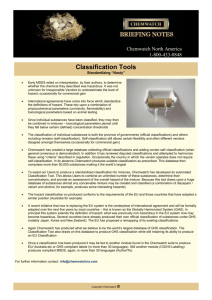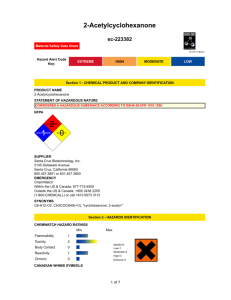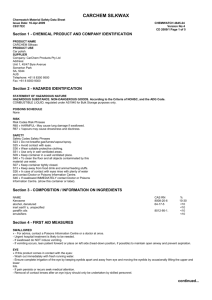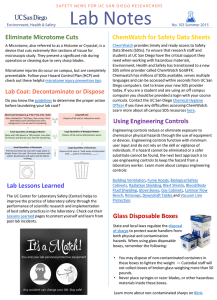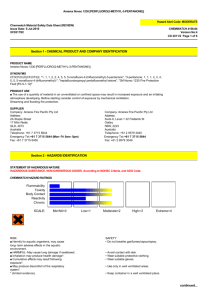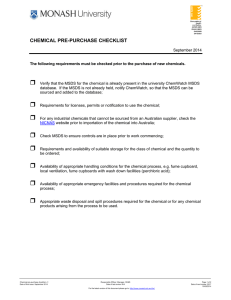Aircraft Pre-spray Insecticide
advertisement
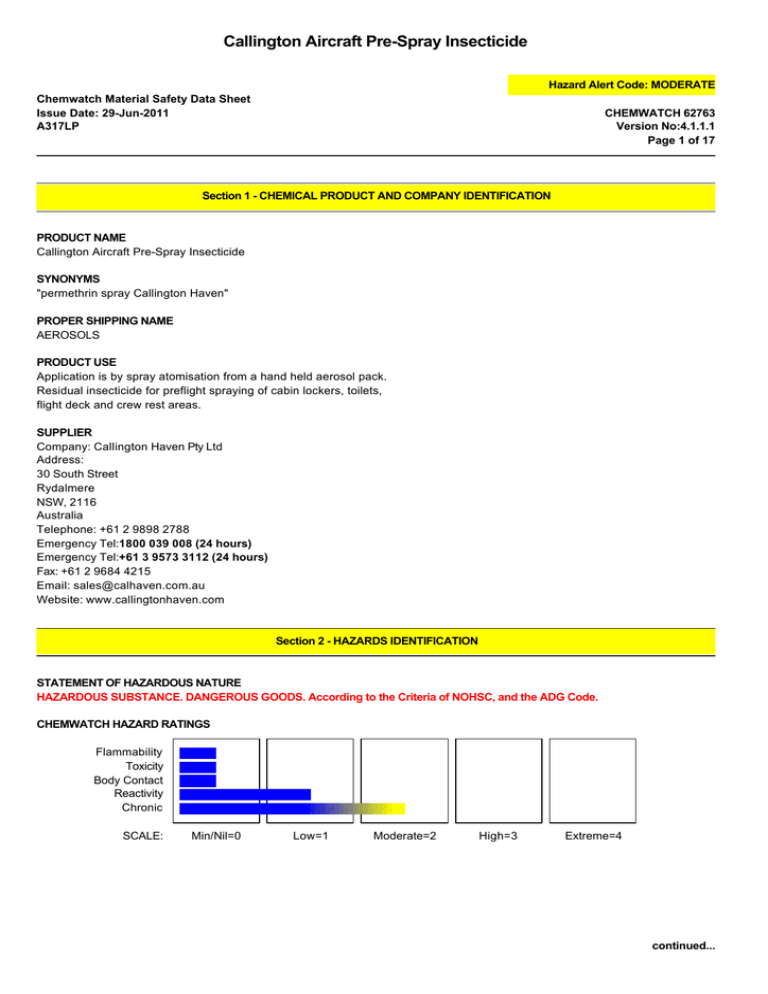
Callington Aircraft Pre-Spray Insecticide Hazard Alert Code: MODERATE Chemwatch Material Safety Data Sheet Issue Date: 29-Jun-2011 A317LP CHEMWATCH 62763 Version No:4.1.1.1 Page 1 of 17 Section 1 - CHEMICAL PRODUCT AND COMPANY IDENTIFICATION PRODUCT NAME Callington Aircraft Pre-Spray Insecticide SYNONYMS "permethrin spray Callington Haven" PROPER SHIPPING NAME AEROSOLS PRODUCT USE Application is by spray atomisation from a hand held aerosol pack. Residual insecticide for preflight spraying of cabin lockers, toilets, flight deck and crew rest areas. SUPPLIER Company: Callington Haven Pty Ltd Address: 30 South Street Rydalmere NSW, 2116 Australia Telephone: +61 2 9898 2788 Emergency Tel:1800 039 008 (24 hours) Emergency Tel:+61 3 9573 3112 (24 hours) Fax: +61 2 9684 4215 Email: sales@calhaven.com.au Website: www.callingtonhaven.com Section 2 - HAZARDS IDENTIFICATION STATEMENT OF HAZARDOUS NATURE HAZARDOUS SUBSTANCE. DANGEROUS GOODS. According to the Criteria of NOHSC, and the ADG Code. CHEMWATCH HAZARD RATINGS Flammability Toxicity Body Contact Reactivity Chronic SCALE: Min/Nil=0 Low=1 Moderate=2 High=3 Extreme=4 continued... Callington Aircraft Pre-Spray Insecticide Hazard Alert Code: MODERATE Chemwatch Material Safety Data Sheet Issue Date: 29-Jun-2011 A317LP CHEMWATCH 62763 Version No:4.1.1.1 Page 2 of 17 Section 2 - HAZARDS IDENTIFICATION RISK ■ May cause SENSITISATION by skin contact. ■ Risk of explosion if heated under confinement. ■ Very toxic to aquatic organisms, may cause long- term adverse effects in the aquatic environment. ■ Inhalation, skin contact and/or ingestion may produce health damage*. ■ Cumulative effects may result following exposure*. ■ May produce discomfort of the respiratory system*. ■ Limited evidence of a carcinogenic effect*. ■ Possible respiratory sensitiser*. SAFETY • Do not breathe gas/fumes/vapour/spray. • Avoid contact with skin. • Use only in well ventilated areas. • Keep container in a well ventilated place. • Do not empty into drains. • To clean the floor and all objects contaminated by this material, use water and detergent. • Keep container tightly closed. • This material and its container must be disposed of in a safe way. • If swallowed, IMMEDIATELY contact Doctor or Poisons Information Centre. (show this container or label). • Use appropriate container to avoid environmental contamination. • Avoid release to the environment. Refer to special instructions/Safety data sheets. • This material and its container must be disposed of as hazardous waste. • In case of accident by inhalation: remove casualty to fresh air and keep at rest. * (limited evidence). Section 3 - COMPOSITION / INFORMATION ON INGREDIENTS NAME permethrin propellant, as HFC NOTE: Manufacturer has supplied full ingredient information to allow CHEMWATCH assessment. CAS RN 52645-53-1 % <10 >60 Section 4 - FIRST AID MEASURES SWALLOWED • Not considered a normal route of entry. continued... Callington Aircraft Pre-Spray Insecticide Hazard Alert Code: MODERATE Chemwatch Material Safety Data Sheet Issue Date: 29-Jun-2011 A317LP CHEMWATCH 62763 Version No:4.1.1.1 Page 3 of 17 Section 4 - FIRST AID MEASURES EYE ■ If aerosols come in contact with the eyes: • Immediately hold the eyelids apart and flush the eye with fresh running water. • Ensure complete irrigation of the eye by keeping eyelids apart and away from eye and moving the eyelids by occasionally lifting the upper and lower lids. • Seek medical attention without delay; if pain persists or recurs seek medical attention. • Removal of contact lenses after an eye injury should only be undertaken by skilled personnel. SKIN ■ If solids or aerosol mists are deposited upon the skin: • Flush skin and hair with running water (and soap if available). • Remove any adhering solids with industrial skin cleansing cream. • DO NOT use solvents. • Seek medical attention in the event of irritation. INHALED ■ If aerosols, fumes or combustion products are inhaled: • Remove to fresh air. • Lay patient down. Keep warm and rested. • Prostheses such as false teeth, which may block airway, should be removed, where possible, prior to initiating first aid procedures. • If breathing is shallow or has stopped, ensure clear airway and apply resuscitation, preferably with a demand valve resuscitator, bag-valve mask device, or pocket mask as trained. Perform CPR if necessary. • Transport to hospital, or doctor. NOTES TO PHYSICIAN Treat symptomatically. For chronic or short term repeated exposures to pyrethrum and synthetic pyrethroids: • Mammalian toxicity of pyrethrum and synthetic pyrethroids is low, in part because of poor bioavailability and a large first pass extraction by the liver. • The most common adverse reaction results from the potent sensitising effects of pyrethrins. • Clinical manifestations of exposure include contact dermatitis (erythema, vesiculation, bullae); anaphylactoid reactions (pallor, tachycardia, diaphoresis) and asthma. [Ellenhorn Barceloux] • In cases of skin contact, it has been reported that topical application of Vitamin E Acetate (alphatocopherol acetate) has been found to have high therapeutic value, eliminating almost all skin pain associated with exposure to synthetic pyrethroids. [Incitec]. Section 5 - FIRE FIGHTING MEASURES EXTINGUISHING MEDIA ■ SMALL FIRE: • Water spray, dry chemical or CO2 LARGE FIRE: • Water spray or fog. FIRE FIGHTING • Alert Fire Brigade and tell them location and nature of hazard. • May be violently or explosively reactive. • Wear breathing apparatus plus protective gloves. • Prevent, by any means available, spillage from entering drains or water course. • If safe, switch off electrical equipment until vapour fire hazard removed. • Use water delivered as a fine spray to control fire and cool adjacent area. continued... Callington Aircraft Pre-Spray Insecticide Hazard Alert Code: MODERATE Chemwatch Material Safety Data Sheet Issue Date: 29-Jun-2011 A317LP CHEMWATCH 62763 Version No:4.1.1.1 Page 4 of 17 Section 5 - FIRE FIGHTING MEASURES • DO NOT approach containers suspected to be hot. • Cool fire exposed containers with water spray from a protected location. • If safe to do so, remove containers from path of fire. • Equipment should be thoroughly decontaminated after use. When any large container (including road and rail tankers) is involved in a fire, consider evacuation by 100 metres in all directions. FIRE/EXPLOSION HAZARD • Non combustible. • Not considered to be a significant fire risk. • Heating may cause expansion or decomposition leading to violent rupture of containers. • Aerosol cans may explode on exposure to naked flames. • Rupturing containers may rocket and scatter burning materials. • Hazards may not be restricted to pressure effects. • May emit acrid, poisonous or corrosive fumes. • Decomposes on heating and may emit toxic fumes of carbon monoxide (CO). Decomposition may produce toxic fumes of: carbon monoxide (CO), carbon dioxide (CO2), hydrogen chloride, phosgene, hydrogen fluoride, other pyrolysis products typical of burning organic material. Contains low boiling substance: Closed containers may rupture due to pressure buildup under fire conditions. FIRE INCOMPATIBILITY • Avoid contamination with oxidising agents i.e. nitrates, oxidising acids, chlorine bleaches, pool chlorine etc. as ignition may result. None known. HAZCHEM 2YE Section 6 - ACCIDENTAL RELEASE MEASURES MINOR SPILLS • Clean up all spills immediately. • Avoid breathing vapours and contact with skin and eyes. • Wear protective clothing, impervious gloves and safety glasses. • Shut off all possible sources of ignition and increase ventilation. • Wipe up. • If safe, damaged cans should be placed in a container outdoors, away from all ignition sources, until pressure has dissipated. • Undamaged cans should be gathered and stowed safely. MAJOR SPILLS • DO NOT exert excessive pressure on valve; DO NOT attempt to operate damaged valve. • Clear area of personnel and move upwind. • Alert Fire Brigade and tell them location and nature of hazard. • May be violently or explosively reactive. • Wear breathing apparatus plus protective gloves. • Prevent, by any means available, spillage from entering drains or water courses • No smoking, naked lights or ignition sources. • Increase ventilation. • Stop leak if safe to do so. • Water spray or fog may be used to disperse / absorb vapour. • Absorb or cover spill with sand, earth, inert materials or vermiculite. continued... Callington Aircraft Pre-Spray Insecticide Hazard Alert Code: MODERATE Chemwatch Material Safety Data Sheet Issue Date: 29-Jun-2011 A317LP CHEMWATCH 62763 Version No:4.1.1.1 Page 5 of 17 Section 6 - ACCIDENTAL RELEASE MEASURES • If safe, damaged cans should be placed in a container outdoors, away from ignition sources, until pressure has dissipated. • Undamaged cans should be gathered and stowed safely. • Collect residues and seal in labelled drums for disposal. • Remove leaking cylinders to a safe place if possible. • Release pressure under safe, controlled conditions by opening the valve. PROTECTIVE ACTIONS FOR SPILL From IERG (Canada/Australia) Isolation Distance Downwind Protection Distance IERG Number 8 metres 49 FOOTNOTES 1 PROTECTIVE ACTION ZONE is defined as the area in which people are at risk of harmful exposure. This zone assumes that random changes in wind direction confines the vapour plume to an area within 30 degrees on either side of the predominant wind direction, resulting in a crosswind protective action distance equal to the downwind protective action distance. 2 PROTECTIVE ACTIONS should be initiated to the extent possible, beginning with those closest to the spill and working away from the site in the downwind direction. Within the protective action zone a level of vapour concentration may exist resulting in nearly all unprotected persons becoming incapacitated and unable to take protective action and/or incurring serious or irreversible health effects. 3 INITIAL ISOLATION ZONE is determined as an area, including upwind of the incident, within which a high probability of localised wind reversal may expose nearly all persons without appropriate protection to lifethreatening concentrations of the material. 4 SMALL SPILLS involve a leaking package of 200 litres (55 US gallons) or less, such as a drum (jerrican or box with inner containers). Larger packages leaking less than 200 litres and compressed gas leaking from a small cylinder are also considered "small spills". LARGE SPILLS involve many small leaking packages or a leaking package of greater than 200 litres, such as a cargo tank, portable tank or a "one-tonne" compressed gas cylinder. 5 Guide 126 is taken from the US DOT emergency response guide book. 6 IERG information is derived from CANUTEC - Transport Canada. Personal Protective Equipment advice is contained in Section 8 of the MSDS. continued... Callington Aircraft Pre-Spray Insecticide Hazard Alert Code: MODERATE Chemwatch Material Safety Data Sheet Issue Date: 29-Jun-2011 A317LP CHEMWATCH 62763 Version No:4.1.1.1 Page 6 of 17 Section 7 - HANDLING AND STORAGE PROCEDURE FOR HANDLING • Avoid all personal contact, including inhalation. • Wear protective clothing when risk of exposure occurs. • Use in a well-ventilated area. • Prevent concentration in hollows and sumps. • DO NOT enter confined spaces until atmosphere has been checked. • Avoid smoking, naked lights or ignition sources. • Avoid contact with incompatible materials. • When handling, DO NOT eat, drink or smoke. • DO NOT incinerate or puncture aerosol cans. • DO NOT spray directly on humans, exposed food or food utensils. • Avoid physical damage to containers. • Always wash hands with soap and water after handling. • Work clothes should be laundered separately. • Use good occupational work practice. • Observe manufacturer's storage and handling recommendations contained within this MSDS. • Atmosphere should be regularly checked against established exposure standards to ensure safe working conditions are maintained. SUITABLE CONTAINER • Aerosol dispenser. • Check that containers are clearly labelled. STORAGE INCOMPATIBILITY Pyrethrins and permethrins: • are unstable in the presence of light, heat, moisture and air • are hydrolysed by oxygen and/ or sunlight • may react with strong oxidisers to produce fire and explosions • are incompatible with alkalis. • Avoid reaction with oxidising agents. STORAGE REQUIREMENTS • Keep dry to avoid corrosion of cans. Corrosion may result in container perforation and internal pressure may eject contents of can. _____________________________________________________ SAFE STORAGE WITH OTHER CLASSIFIED CHEMICALS + X + X X + _____________________________________________________ +: May be stored together O: May be stored together with specific preventions X: Must not be stored together continued... Callington Aircraft Pre-Spray Insecticide Hazard Alert Code: MODERATE Chemwatch Material Safety Data Sheet Issue Date: 29-Jun-2011 A317LP CHEMWATCH 62763 Version No:4.1.1.1 Page 7 of 17 Section 8 - EXPOSURE CONTROLS / PERSONAL PROTECTION EXPOSURE CONTROLS The following materials had no OELs on our records • permethrin: CAS:52645- 53- 1 CAS:54774- 45- 7 CAS:57608- 04- 5 CAS:93388- 66- 0 CAS:63364- 00- 1 CAS:60018- 94- 2 CAS:75497- 64- 2 MATERIAL DATA CALLINGTON AIRCRAFT PRE-SPRAY INSECTICIDE: PERMETHRIN: For pyrethrum and its active components: IDLH Level: 5000 mg/m3 Pyrethrum and/or its active components, the pyrethrins, cause dermatitis and sensitisation. Ingestion of massive doses can induce convulsions, vomiting and bradycardia. Animals exhibit liver damage and death through respiratory failure. The recommended TLV-TWA is equivalent to an occupational dose of 0.7 mg/kg/day and is thought to minimise the potential for systemic effects. The TLV may NOT prevent the development of hypersensitisation, particularly among those with pre-existing allergies to pollen and related agents. Synthetic pyrethrins (pyrethroids) often produce a range of toxic effects resembling pyrethrum; in the absence of a regulated exposure limit prudence dictates that the value for pyrethrum serves as a reference. PERSONAL PROTECTION EYE ■ No special equipment for minor exposure i.e. when handling small quantities. OTHERWISE: For potentially moderate or heavy exposures: • Safety glasses with side shields. • NOTE: Contact lenses pose a special hazard; soft lenses may absorb irritants and ALL lenses concentrate them. HANDS/FEET ■ NOTE: • The material may produce skin sensitisation in predisposed individuals. Care must be taken, when removing gloves and other protective equipment, to avoid all possible skin contact. • Contaminated leather items, such as shoes, belts and watch-bands should be removed and destroyed. • No special equipment needed when handling small quantities. • OTHERWISE: • For potentially moderate exposures: • Wear general protective gloves, eg. light weight rubber gloves. • For potentially heavy exposures: • Wear chemical protective gloves, eg. PVC. and safety footwear. continued... Callington Aircraft Pre-Spray Insecticide Hazard Alert Code: MODERATE Chemwatch Material Safety Data Sheet Issue Date: 29-Jun-2011 A317LP CHEMWATCH 62763 Version No:4.1.1.1 Page 8 of 17 Section 8 - EXPOSURE CONTROLS / PERSONAL PROTECTION OTHER ■ No special equipment needed when handling small quantities. OTHERWISE: • Overalls. • Skin cleansing cream. • Eyewash unit. • Do not spray on hot surfaces. RESPIRATOR ■ Cartridge respirators should never be used for emergency ingress or in areas of unknown vapour concentrations or oxygen content. The wearer must be warned to leave the contaminated area immediately on detecting any odours through the respirator. The odour may indicate that the mask is not functioning properly, that the vapour concentration is too high, or that the mask is not properly fitted. Because of these limitations, only restricted use of cartridge respirators is considered appropriate. The local concentration of material, quantity and conditions of use determine the type of personal protective equipment required. For further information consult site specific CHEMWATCH data (if available), or your Occupational Health and Safety Advisor. ENGINEERING CONTROLS ■ Engineering controls are used to remove a hazard or place a barrier between the worker and the hazard. Welldesigned engineering controls can be highly effective in protecting workers and will typically be independent of worker interactions to provide this high level of protection. The basic types of engineering controls are: Process controls which involve changing the way a job activity or process is done to reduce the risk. Enclosure and/or isolation of emission source which keeps a selected hazard "physically" away from the worker and ventilation that strategically "adds" and "removes" air in the work environment. Ventilation can remove or dilute an air contaminant if designed properly. The design of a ventilation system must match the particular process and chemical or contaminant in use. Employers may need to use multiple types of controls to prevent employee overexposure. General exhaust is adequate under normal conditions. If risk of overexposure exists, wear SAA approved respirator. Correct fit is essential to obtain adequate protection. Provide adequate ventilation in warehouse or closed storage areas. Section 9 - PHYSICAL AND CHEMICAL PROPERTIES APPEARANCE Liquid in aerosol pack. Contains non-combustible propellant. PHYSICAL PROPERTIES Liquid. Gas. Does not mix with water. State Melting Range (°C) Boiling Range (°C) Flash Point (°C) Decomposition Temp (°C) Liquid Not Available Not Available Not Applicable Not Available Molecular Weight Viscosity Solubility in water (g/L) pH (1% solution) pH (as supplied) Not Applicable Not Available Immiscible Not Applicable Not Applicable continued... Callington Aircraft Pre-Spray Insecticide Hazard Alert Code: MODERATE Chemwatch Material Safety Data Sheet Issue Date: 29-Jun-2011 A317LP CHEMWATCH 62763 Version No:4.1.1.1 Page 9 of 17 Section 9 - PHYSICAL AND CHEMICAL PROPERTIES Autoignition Temp (°C) Upper Explosive Limit (%) Lower Explosive Limit (%) Not Applicable Not Applicable Not Applicable Volatile Component (%vol) Not Available Vapour Pressure (kPa) Specific Gravity (water=1) Relative Vapour Density (air=1) Evaporation Rate Not Available Not Available >1 Not Available Section 10 - STABILITY AND REACTIVITY CONDITIONS CONTRIBUTING TO INSTABILITY • Elevated temperatures. • Presence of open flame. • Product is considered stable. • Hazardous polymerisation will not occur. For incompatible materials - refer to Section 7 - Handling and Storage. Section 11 - TOXICOLOGICAL INFORMATION POTENTIAL HEALTH EFFECTS ACUTE HEALTH EFFECTS SWALLOWED ■ Accidental ingestion of the material may be damaging to the health of the individual. Overexposure is unlikely in this form. Ingestion of pyrethrins may produce nausea, vomiting, headache, muscle tremors, shock and perhaps death. Its fatal human dose is estimated at 100 grams per 70 kg man (1430 mg/kg). Not normally a hazard due to physical form of product. Considered an unlikely route of entry in commercial/industrial environments. EYE ■ Not considered to be a risk because of the extreme volatility of the gas. SKIN ■ Skin contact with the material may damage the health of the individual; systemic effects may result following absorption. Skin contact with natural pyrethrins may cause severe inflammation, hayfever and asthma. If they are absorbed through the skin, the same toxic effects as inhalation can occur; the liver and kidney may be damaged. Long term exposure may cause central nervous system effects and allergic skin reaction. Spray mist may produce discomfort. Open cuts, abraded or irritated skin should not be exposed to this material. Entry into the blood-stream, through, for example, cuts, abrasions or lesions, may produce systemic injury with harmful effects. Examine the skin prior to the use of the material and ensure that any external damage is suitably protected. INHALED ■ Inhalation of aerosols (mists, fumes), generated by the material during the course of normal handling, may be damaging to the health of the individual. There is some evidence to suggest that the material can cause respiratory irritation in some persons. The body's response to such irritation can cause further lung damage. Inhalation of pyrethrins may produce nausea, vomiting, sneezing, serious discharge from the nose, blocked continued... Callington Aircraft Pre-Spray Insecticide Hazard Alert Code: MODERATE Chemwatch Material Safety Data Sheet Issue Date: 29-Jun-2011 A317LP CHEMWATCH 62763 Version No:4.1.1.1 Page 10 of 17 Section 11 - TOXICOLOGICAL INFORMATION nose and asthma. High concentrations may produce excessive excitement, inco-ordination, tremors, muscle paralysis and death (due to failure of breathing). Sometimes there may be temporary tingling in the face which lasts a few hours after exposure. Inhalation of toxic gases may cause: • Central Nervous System effects including depression, headache, confusion, dizziness, stupor, coma and seizures; • respiratory: acute lung swellings, shortness of breath, wheezing, rapid breathing, other symptoms and respiratory arrest; • heart: collapse, irregular heartbeats and cardiac arrest; • gastrointestinal: irritation, ulcers, nausea and vomiting (may be bloody), and abdominal pain. Material is highly volatile and may quickly form a concentrated atmosphere in confined or unventilated areas. The vapour may displace and replace air in breathing zone, acting as a simple asphyxiant. This may happen with little warning of overexposure. Symptoms of asphyxia (suffocation) may include headache, dizziness, shortness of breath, muscular weakness, drowsiness and ringing in the ears. If the asphyxia is allowed to progress, there may be nausea and vomiting, further physical weakness and unconsciousness and, finally, convulsions, coma and death. Significant concentrations of the non-toxic gas reduce the oxygen level in the air. As the amount of oxygen is reduced from 21 to 14 volume %, the pulse rate accelerates and the rate and volume of breathing increase. The ability to maintain attention and think clearly is diminished and muscular coordination is somewhat disturbed. As oxygen decreases from 14-10% judgement becomes faulty; severe injuries may cause no pain. Muscular exertion leads to rapid fatigue. Further reduction to 6% may produce nausea and vomiting and the ability to move may be lost. Permanent brain damage may result even after resuscitation at exposures to this lower oxygen level. Below 6% breathing is in gasps and convulsions may occur. Inhalation of a mixture containing no oxygen may result in unconsciousness from the first breath and death will follow in a few minutes. WARNING:Intentional misuse by concentrating/inhaling contents may be lethal. CHRONIC HEALTH EFFECTS ■ Skin contact with the material is more likely to cause a sensitisation reaction in some persons compared to the general population. There has been some concern that this material can cause cancer or mutations but there is not enough data to make an assessment. Substance accumulation, in the human body, may occur and may cause some concern following repeated or longterm occupational exposure. There is some evidence that inhaling this product is more likely to cause a sensitisation reaction in some persons compared to the general population. Chronic poisoning by natural pyrethrins may result in convulsion, paralysis with extreme muscle tone, rapid and uneven heart beat, liver and kidney damage, or death. Natural pyrethrins may cause hypersensitivity especially if past exposure has occurred. Generally it takes 2-3 years of repeated exposure for this to develop, and it usually follows exposure to pyrethrum rather than its individual components. The most common syndrome consists of skin inflammation with blisters, itchiness, local swelling, nose inflammation, increased heart rate, pallor and sweating. Skin effects can progress to swelling and cracking. Inflammation of the skin increases in hot weather or when sweating. Patients allergic to ragweed pollen are especially sensitive to pyrethrin. Principal route of occupational exposure to the gas is by inhalation. TOXICITY AND IRRITATION ■ unless otherwise specified data extracted from RTECS - Register of Toxic Effects of Chemical Substances. ■ The following information refers to contact allergens as a group and may not be specific to this product. Contact allergies quickly manifest themselves as contact eczema, more rarely as urticaria or Quincke's oedema. The pathogenesis of contact eczema involves a cell-mediated (T lymphocytes) immune reaction of the delayed type. Other allergic skin reactions, e.g. contact urticaria, involve antibody-mediated immune reactions. The significance of the contact allergen is not simply determined by its sensitisation potential: continued... Callington Aircraft Pre-Spray Insecticide Hazard Alert Code: MODERATE Chemwatch Material Safety Data Sheet Issue Date: 29-Jun-2011 A317LP CHEMWATCH 62763 Version No:4.1.1.1 Page 11 of 17 Section 11 - TOXICOLOGICAL INFORMATION the distribution of the substance and the opportunities for contact with it are equally important. A weakly sensitising substance which is widely distributed can be a more important allergen than one with stronger sensitising potential with which few individuals come into contact. From a clinical point of view, substances are noteworthy if they produce an allergic test reaction in more than 1% of the persons tested. PERMETHRIN: TOXICITY IRRITATION Oral (rat) LD50:383 mg/kg Skin (rabbit):500 mg/24h - Mild Inhalation (rat) LC50:485 mg/m³ Dermal (rat) LD50:1750 mg/kg Dermal (mouse) LD50:>10000 mg/kg Oral (rabbit) LD50:4000 mg/kg Dermal (rabbit) LD50:>2000 mg/kg Oral (g.pig) LD50:4000 mg/kg Oral (rat) LD50:6000 mg/kg * ■ The material may cause skin irritation after prolonged or repeated exposure and may produce on contact skin redness, swelling, the production of vesicles, scaling and thickening of the skin. The substance is classified by IARC as Group 3: NOT classifiable as to its carcinogenicity to humans. Evidence of carcinogenicity may be inadequate or limited in animal testing. [ * The Pesticides Manual, Incorporating The Agrochemicals Handbook, 10th Edition, Editor Clive Tomlin, 1994, British Crop Protection Council]. Oral (rat) LD50: 430-4000 mg/kg * Oral (mouse) LD50: 540-2960 mg/kg * cis/trans ratio: 40:60 cis/trans ratio: 20:80 ADI: 0.05 mg/kg for nominal cis-trans 40:60 and 25:75 isomers only CARCINOGEN permethrin permethrin International Agency for Research on Cancer (IARC) - Agents Reviewed by the IARC Monographs International Agency for Research on Cancer (IARC) - Agents Reviewed by the IARC Monographs Group 3 Not classifiable as to its carcinogenicity to humans Group 2A Probably carcinogenic to humans Section 12 - ECOLOGICAL INFORMATION PERMETHRIN: Marine Pollutant Fish LC50 (96hr.) (mg/l): log Kow (Sangster 1997): Yes 0.0006- 0.0 6.5 continued... Callington Aircraft Pre-Spray Insecticide Hazard Alert Code: MODERATE Chemwatch Material Safety Data Sheet Issue Date: 29-Jun-2011 A317LP CHEMWATCH 62763 Version No:4.1.1.1 Page 12 of 17 Section 12 - ECOLOGICAL INFORMATION log Pow (Verschueren 1983): 3.48 Very toxic to aquatic organisms, may cause long-term adverse effects in the aquatic environment. Do NOT allow product to come in contact with surface waters or to intertidal areas below the mean high water mark. Do not contaminate water when cleaning equipment or disposing of equipment wash-waters. Wastes resulting from use of the product must be disposed of on site or at approved waste sites. For synthetic pyrethroids: Environmental Fate: Synthetic pyrethroids are examples of optimised insecticidal activity, selectivity and tailored environmental persistence. Through modifications of both acid and alcohol portions of the ester, compounds of desired residual activity have been synthesised whilst maintaining a biodegradable ester linkage. While these compounds are generally very toxic to crustaceans and fish in laboratory bio assays, under field conditions, the residues are tightly bound in sediment, and ingested residues are readily metabolised, resulting in their toxicity in natural systems generally being less than laboratory test data might indicate. They are generally non-persistent in the environment, as pyrethroid concentrations decrease rapidly due to sorption to sediment, suspended particles and plants. Microbial and photodegradation also occur. Pyrethrins are generally unstable in the presence of light, are hydrolysed rapidly under alkaline conditions and oxidise rapidly in air. Vapour phase pyrethrins may combine chemically with ozone to produce hydroxy radicals. Pyrethroids that are more stable to sunlight include permethrin, deltamethrin, cyhalothrin, cyfluthrin, and cypermethrin and are thus more frequently applied outdoors to crops in comparison to the rapidly degraded pyrethroids like resmethrin and allethrin. Because agricultural dose rates are low and biological degradation is generally rapid, residues are unlikely to attain significant levels. Permethrin disappears from ponds and streams within 6-24 hours, pond sediments within 7 days and foliage and forest soil within 58 days. Pyrethrins and pyrethroids are degraded by light both in the atmosphere and sunlit surface waters. The rate of photolysis in water is increased when fulvic and humic acids are present. Pyrethroids and pyrethrins also undergo hydrolysis in the environment at varying rates depending upon pH and temperature. Generally, hydrolysis is only an important environmental fate process under alkaline conditions and at temperatures of 20 deg. C or greater. Pyrethrins and pyrethroids are expected to exist in both vapour and particulate phases in the ambient atmosphere. Vapor phase pyrethrins and pyrethroids are rapidly degraded in the atmosphere by direct photolysis and reaction with oxidants found in air such as photochemically-produced hydroxyl radicals, ozone, and nitrate radicals. Particulate phase compounds are slower to degrade and can travel long distances before being removed from the air by wet and dry deposition. Pyrethrins and pyrethroids adhere strongly to soil surfaces and are not very mobile so leaching potential is low. Photolysis is only an important environmental fate at the surface of the soil as light cannot penetrate to deeper layers of the soil. The potential for significant toxicity is not reached in field conditions. Under aerobic conditions in soil, permethrin degrades in a relatively short time (half-life 28 days). Volatilisation from water and soil is expected to occur slowly for many of the pyrethroids. When released to water, partitioning to suspended solids and sediment occurs rapidly. These compounds adsorb strongly to suspended solids and sediment in the water column, and this process significantly reduces the potential for volatilisation. Volatilisation losses from foliage may be considerably greater than volatilisation from soils because pyrethrins and pyrethroids do not adsorb as strongly to the leafy component of vegetation as to soils. Pyrethrins and pyrethroids are often used indoors in sprays or aerosol bombs, and the volatilisation rates from glass or floor surfaces may be significantly faster than from soils since these compounds are not likely to adsorb as strongly to these surfaces. Little data exist regarding the uptake and transport of pyrethrins and pyrethroids by plant material. Since many of these compounds are rapidly degraded in the environment, this transport mechanism may not be an important environmental fate process other than the initial settling of these compounds on the canopy following deposition. The aerial surface of a plant, including foliage, is covered by a cuticle, which serves as a barrier to water loss and to prevent penetration of applied chemicals or environmental pollutants. Once deposited on the surface, a chemical may be degraded, bind to the cuticle, or diffuse into the plant through the stomata. Since pyrethrins and pyrethroids adsorb strongly to soils, their uptake from roots and transport within plants is expected to be limited. Humans are exposed to pyrethrins and pyrethroids primarily from food sources, especially fruits and vegetables. The tendency of young children to ingest soil, either intentionally or unintentionally can result in ingestion of pyrethrins and pyrethroids present in soil and dust. Since these compounds are adsorbed continued... Callington Aircraft Pre-Spray Insecticide Hazard Alert Code: MODERATE Chemwatch Material Safety Data Sheet Issue Date: 29-Jun-2011 A317LP CHEMWATCH 62763 Version No:4.1.1.1 Page 13 of 17 Section 12 - ECOLOGICAL INFORMATION strongly to soils, they may not be in a highly bioavailable form. Young children often play on the ground or on carpets and this will increase the likelihood of skin exposure and inhalation of contaminated particles from soil, household dust and treated surfaces. Drinking Water Standards: pesticide 0.1 ug/l (UK max.) Ecotoxicity: Synthetic pyrethroids are extremely effective against insects, but are relatively safe to mammals and birds. Pyrethroids are extreme toxic to aquatic organisms, where often <1 ug/L will produce toxic effects. The half-lives for elimination of several pyrethroids by trout are all greater than 48 hours, while elimination half-lives in birds and mammals range from 6 to 12 hours. Pyrethroids are highly toxic to fish; with 96-hour LC50 values generally below 10 ug/l. Corresponding LD50 values in mammals and birds are in the range of several hundred to several thousand mg/kg. Fish sensitivity to the pyrethroids may be explained by their relatively slow metabolism and elimination of these compounds. The half-lives for elimination of several pyrethroids by trout are all greater than 48 hours, while elimination half-lives for birds and mammals range from 6 to 12 hours Generally, the lethality of pyrethroids to fish increases with increasing octanol/water partition coefficients The bioaccumulation factor of cypermethrin in fish is approximately 1000 when measured experimentally. Substances containing unsaturated carbons are ubiquitous in indoor environments. They result from many sources (see below). Most are reactive with environmental ozone and many produce stable products which are thought to adversely affect human health.The potential for surfaces in an enclosed space to facilitate reactions should be considered. Source of unsaturated substances Occupants (exhaled breath, ski oils, personal care products) Unsaturated substances (Reactive Emissions) Isoprene, nitric oxide, squalene, unsaturated sterols, oleic acid and other unsaturated fatty acids, unsaturated oxidation products Soft woods, wood flooring, including cypress, cedar and silver fir boards, houseplants Isoprene, limonene, alphapinene, other terpenes and sesquiterpenes Carpets and carpet backing 4- Phenylcyclohexene, 4vinylcyclohexene, styrene, 2ethylhexyl acrylate, unsaturated fatty acids and esters Linoleic acid, linolenic acid Linoleum and paints/polishes containing linseed oil Latex paint Certain cleaning products, polishes, waxes, air fresheners Residual monomers Limonene, alpha- pinene, terpinolene, alpha- terpineol, linalool, linalyl acetate and other terpenoids, longifolene and other sesquiterpenes Natural rubber adhesive Isoprene, terpenes Major Stable Products produced following reaction with ozone. Methacrolein, methyl vinyl ketone, nitrogen dioxide, acetone, 6MHQ, geranyl acetone, 4OPA, formaldehyde, nonanol, decanal, 9- oxo- nonanoic acid, azelaic acid, nonanoic acid. Formaldehyde, 4- AMC, pinoaldehyde, pinic acid, pinonic acid, formic acid, methacrolein, methyl vinyl ketone, SOAs including ultrafine particles Formaldehyde, acetaldehyde, benzaldehyde, hexanal, nonanal, 2- nonenal Propanal, hexanal, nonanal, 2heptenal, 2- nonenal, 2decenal, 1- pentene- 3- one, propionic acid, n- butyric acid Formaldehyde Formaldehyde, acetaldehyde, glycoaldehyde, formic acid, acetic acid, hydrogen and organic peroxides, acetone, benzaldehyde, 4- hydroxy- 4methyl- 5- hexen- 1- al, 5ethenyl- dihydro- 5- methyl2(3H)- furanone, 4- AMC, SOAs including ultrafine particles Formaldehyde, methacrolein, methyl vinyl ketone continued... Callington Aircraft Pre-Spray Insecticide Hazard Alert Code: MODERATE Chemwatch Material Safety Data Sheet Issue Date: 29-Jun-2011 A317LP CHEMWATCH 62763 Version No:4.1.1.1 Page 14 of 17 Section 12 - ECOLOGICAL INFORMATION Photocopier toner, printed paper, styrene polymers Environmental tobacco smoke Styrene Formaldehyde, benzaldehyde Styrene, acrolein, nicotine Soiled clothing, fabrics, bedding Squalene, unsaturated sterols, oleic acid and other saturated fatty acids Soiled particle filters Unsaturated fatty acids from plant waxes, leaf litter, and other vegetative debris; soot; diesel particles Ventilation ducts and duct liners Unsaturated fatty acids and esters, unsaturated oils, neoprene Polycyclic aromatic hydrocarbons Formaldehyde, benzaldehyde, hexanal, glyoxal, Nmethylformamide, nicotinaldehyde, cotinine Acetone, geranyl acetone, 6MHO, 40PA, formaldehyde, nonanal, decanal, 9- oxo- nonanoic acid, azelaic acid, nonanoic acid Formaldehyde, nonanal, and other aldehydes; azelaic acid; nonanoic acid; 9- oxo- nonanoic acid and other oxo- acids; compounds with mixed functional groups (=O, - OH, and - COOH) C5 to C10 aldehydes " Urban grime" Perfumes, colognes, essential oils (e.g. lavender, eucalyptus, tea tree) Limonene, alpha- pinene, linalool, linalyl acetate, terpinene- 4- ol, gammaterpinene Overall home emissions Limonene, alpha- pinene, styrene Oxidized polycyclic aromatic hydrocarbons Formaldehyde, 4- AMC, acetone, 4- hydroxy- 4- methyl- 5- hexen1- al, 5- ethenyl- dihydro- 5methyl- 2(3H) furanone, SOAs including ultrafine particles Formaldehyde, 4- AMC, pinonaldehyde, acetone, pinic acid, pinonic acid, formic acid, benzaldehyde, SOAs including ultrafine particles Abbreviations: 4-AMC, 4-acetyl-1-methylcyclohexene; 6MHQ, 6-methyl-5-heptene-2-one, 4OPA, 4-oxopentanal, SOA, Secondary Organic Aerosols Reference: Charles J Weschler; Environmental Helath Perspectives, Vol 114, October 2006. DO NOT discharge into sewer or waterways. The material is classified as an ecotoxin* because the Fish LC50 (96 hours) is less than or equal to 0.1 mg/l * Classification of Substances as Ecotoxic (Dangerous to the Environment) Appendix 8, Table 1 Compiler's Guide for the Preparation of International Chemical Safety Cards: 1993 Commission of the European Communities. log Kow: 3.48-6.5 Half-life (hr) soil: 288-648 BCF: 30-2480* * Muir et al. 1994 Aquatic Toxicology 29(3/4)223-240 Toxicity Class WHO: II (Ambush); III (Outflank) In soil and water degradation rapid: DT50 in soil <38 days (pH 4.2-7.7 o.m. 1.3-51.3%) Oral (chicken) LD50: 7000 mg/kg Oral (quail) LD50: 13500 mg/kg Oral (duck) LD50: 11300 mg/kg continued... Callington Aircraft Pre-Spray Insecticide Hazard Alert Code: MODERATE Chemwatch Material Safety Data Sheet Issue Date: 29-Jun-2011 A317LP Ecotoxicity Ingredient permethrin CHEMWATCH 62763 Version No:4.1.1.1 Page 15 of 17 Section 12 - ECOLOGICAL INFORMATION Persistence: Water/Soil HIGH Persistence: Air Bioaccumulation Mobility No Data Available HIGH LOW Section 13 - DISPOSAL CONSIDERATIONS • DO NOT allow wash water from cleaning or process equipment to enter drains. • It may be necessary to collect all wash water for treatment before disposal. • In all cases disposal to sewer may be subject to local laws and regulations and these should be considered first. • Where in doubt contact the responsible authority. • Consult State Land Waste Management Authority for disposal. • Discharge contents of damaged aerosol cans at an approved site. • Allow small quantities to evaporate. • DO NOT incinerate or puncture aerosol cans. • Bury residues and emptied aerosol cans at an approved site. Section 14 - TRANSPORTATION INFORMATION Labels Required: NON-FLAMMABLE COMPRESSED GAS HAZCHEM: 2YE (ADG7) ADG7: Class or Division UN No.: Special Provision: Portable Tanks & Bulk Containers - Instruction: Packagings & IBCs - Packing Instruction: Name and Description: AEROSOLS Air Transport IATA: ICAO/IATA Class UN/ID Number: Special provisions: Cargo Only 2.2 1950 63 190 277 327 None P003 LP02 Subsidiary Risk1: Packing Group: Limited Quantity: None None See SP 277 Portable Tanks & Bulk Containers - Special Provision: Packagings & IBCs - Special Packing Provision: None 2.2 1950 A145A167A802 ICAO/IATA Subrisk: Packing Group: PP17 PP87 L2 None - continued... Callington Aircraft Pre-Spray Insecticide Hazard Alert Code: MODERATE Chemwatch Material Safety Data Sheet Issue Date: 29-Jun-2011 A317LP Packing Instructions: Passenger and Cargo Packing Instructions: Passenger and Cargo Limited Quantity Packing Instructions: CHEMWATCH 62763 Version No:4.1.1.1 Page 16 of 17 Section 14 - TRANSPORTATION INFORMATION 203 203 Y203 Maximum Qty/Pack: Passenger and Cargo Maximum Qty/Pack: Passenger and Cargo Limited Quantity Maximum Qty/Pack: 150 kg 75 kg 30 kg G Shipping name:AEROSOLS Maritime Transport IMDG: IMDG Class 2.2 UN Number: 1950 EMS Number: F-D,S-U Limited Quantities: SP277 Shipping name:AEROSOLS IMDG Subrisk: Packing Group: Special provisions: Marine Pollutant: None None 63 190 277 327 344 959 Yes Section 15 - REGULATORY INFORMATION Indications of Danger: N Dangerous for the environment Xi Irritant POISONS SCHEDULE None REGULATIONS Callington Aircraft Pre-Spray Insecticide (CAS: ) is found on the following regulatory lists; "Australia ADI list - Acceptable daily intakes for agricultural and veterinary chemicals", "Australia FAISD Handbook - First Aid Instructions, Warning Statements, and General Safety Precautions", "Australia Hazardous Substances Information System - Consolidated Lists", "Australia New Zealand Food Standards Code Maximum Residue Limits (Australia only) - Schedule 1", "Australia New Zealand Food Standards Code - Maximum Residue Limits (Australia only) - Schedule 3 - Chemical Groups", "Australia Standard for the Uniform Scheduling of Medicines and Poisons (SUSMP) - Schedule 2", "Australia Standard for the Uniform Scheduling of Medicines and Poisons (SUSMP) - Schedule 5" Regulations for ingredients permethrin (CAS: 52645-53-1, 54774-45-7, 57608-04-5, 93388-66-0, 63364-00-1, 60018-94-2, 7549764-2) is found on the following regulatory lists; "Australia - Australian Capital Territory - Environment Protection Regulation: Ambient environmental standards (Domestic water supply - pesticides)", "Australia - Australian Capital Territory - Environment Protection Regulation: Pollutants entering waterways taken to cause environmental harm - Domestic water supply quality", "Australia ADI list - Acceptable daily intakes for agricultural and veterinary chemicals", "Australia Australian Pesticides and Veterinary Medicines Authority (APVM) Record of approved active constituents", "Australia Drinking Water Guideline Values for Pesticides", "Australia Drinking Water Guideline Values For Physical and Chemical Characteristics", "Australia FAISD Handbook - First Aid Instructions, Warning Statements, and General Safety Precautions", "Australia Hazardous Substances Information System - Consolidated Lists", "Australia Inventory of Chemical Substances (AICS)", "Australia National Pollutant Inventory", "Australia New Zealand Food Standards Code - Maximum Residue Limits (Australia only) - Schedule 1", "Australia New Zealand Food Standards Code - Maximum Residue Limits (Australia only) - continued... Callington Aircraft Pre-Spray Insecticide Hazard Alert Code: MODERATE Chemwatch Material Safety Data Sheet Issue Date: 29-Jun-2011 A317LP CHEMWATCH 62763 Version No:4.1.1.1 Page 17 of 17 Section 15 - REGULATORY INFORMATION Schedule 3 - Chemical Groups", "Australia Quarantine and Inspection Service List of chemical compounds that are accepted solely for use at establishments registered to prepare meat and meat products for the purpose of the Export Control Act 1982", "Australia Standard for the Uniform Scheduling of Medicines and Poisons (SUSMP) - Schedule 2", "Australia Standard for the Uniform Scheduling of Medicines and Poisons (SUSMP) - Schedule 4", "Australia Standard for the Uniform Scheduling of Medicines and Poisons (SUSMP) - Schedule 5", "Australia Standard for the Uniform Scheduling of Medicines and Poisons (SUSMP) - Schedule 6", "International Agency for Research on Cancer (IARC) - Agents Reviewed by the IARC Monographs", "International Air Transport Association (IATA) Dangerous Goods Regulations", "International Maritime Dangerous Goods Requirements (IMDG Code) Marine Pollutants", "OSPAR Substances removed from the List of Substances of Possible Concern", "SigmaAldrichTransport Information", "WHO Guidelines for Drinking-water Quality - Chemicals for which guideline values have not been established" Section 16 - OTHER INFORMATION INGREDIENTS WITH MULTIPLE CAS NUMBERS Ingredient Name CAS permethrin 52645-53-1, 54774-45-7, 57608-04-5, 93388-66-0, 63364-00-1, 60018-94-2, 75497-64-2 ■ Classification of the preparation and its individual components has drawn on official and authoritative sources as well as independent review by the Chemwatch Classification committee using available literature references. A list of reference resources used to assist the committee may be found at: www.chemwatch.net/references. ■ The (M)SDS is a Hazard Communication tool and should be used to assist in the Risk Assessment. Many factors determine whether the reported Hazards are Risks in the workplace or other settings. Risks may be determined by reference to Exposures Scenarios. Scale of use, frequency of use and current or available engineering controls must be considered. This document is copyright. Apart from any fair dealing for the purposes of private study, research, review or criticism, as permitted under the Copyright Act, no part may be reproduced by any process without written permission from CHEMWATCH. TEL (+61 3) 9572 4700. Issue Date: 29-Jun-2011 Print Date: 6-Feb-2014 This is the end of the MSDS.
